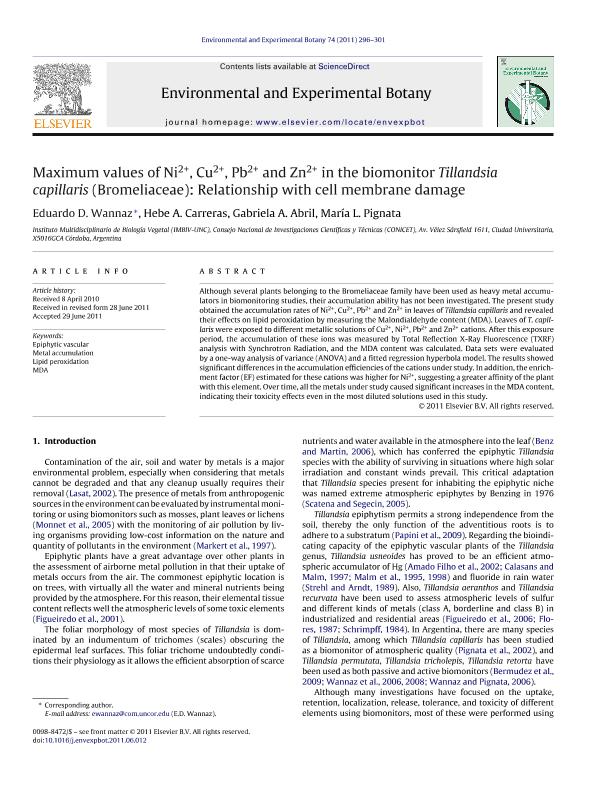Artículo
Maximum values of Ni2+, Cu2+, Pb2+ and Zn2+ in the biomonitor Tillandsia capillaris (Bromeliaceae): Relationship with cell membrane damage
Wannaz, Eduardo Daniel ; Carreras, Hebe Alejandra
; Carreras, Hebe Alejandra ; Abril, Gabriela Alejandra
; Abril, Gabriela Alejandra ; Pignata, Maria Luisa
; Pignata, Maria Luisa
 ; Carreras, Hebe Alejandra
; Carreras, Hebe Alejandra ; Abril, Gabriela Alejandra
; Abril, Gabriela Alejandra ; Pignata, Maria Luisa
; Pignata, Maria Luisa
Fecha de publicación:
12/2011
Editorial:
Pergamon-Elsevier Science Ltd
Revista:
Environmental and Experimental Botany
ISSN:
0098-8472
Idioma:
Inglés
Tipo de recurso:
Artículo publicado
Clasificación temática:
Resumen
Although several plants belonging to the Bromeliaceae family have been used as heavy metal accumulators in biomonitoring studies, their accumulation ability has not been investigated. The present study obtained the accumulation rates of Ni2+, Cu2+, Pb2+ and Zn2+ in leaves of Tillandsia capillaris and revealed their effects on lipid peroxidation by measuring the Malondialdehyde content (MDA). Leaves of T. capillaris were exposed to different metallic solutions of Cu2+, Ni2+, Pb2+ and Zn2+ cations. After this exposure period, the accumulation of these ions was measured by Total Reflection X-Ray Fluorescence (TXRF) analysis with Synchrotron Radiation, and the MDA content was calculated. Data sets were evaluated by a one-way analysis of variance (ANOVA) and a fitted regression hyperbola model. The results showed significant differences in the accumulation efficiencies of the cations under study. In addition, the enrichment factor (EF) estimated for these cations was higher for Ni2+, suggesting a greater affinity of the plant with this element. Over time, all the metals under study caused significant increases in the MDA content, indicating their toxicity effects even in the most diluted solutions used in this study.
Palabras clave:
EPIPHYTIC VASCULAR
,
LIPID PEROXIDATION
,
MDA
,
METAL ACCUMULATION
Archivos asociados
Licencia
Identificadores
Colecciones
Articulos(IMBIV)
Articulos de INST.MULTIDISCIPL.DE BIOLOGIA VEGETAL (P)
Articulos de INST.MULTIDISCIPL.DE BIOLOGIA VEGETAL (P)
Citación
Wannaz, Eduardo Daniel; Carreras, Hebe Alejandra; Abril, Gabriela Alejandra; Pignata, Maria Luisa; Maximum values of Ni2+, Cu2+, Pb2+ and Zn2+ in the biomonitor Tillandsia capillaris (Bromeliaceae): Relationship with cell membrane damage; Pergamon-Elsevier Science Ltd; Environmental and Experimental Botany; 74; 1; 12-2011; 296-301
Compartir
Altmétricas



